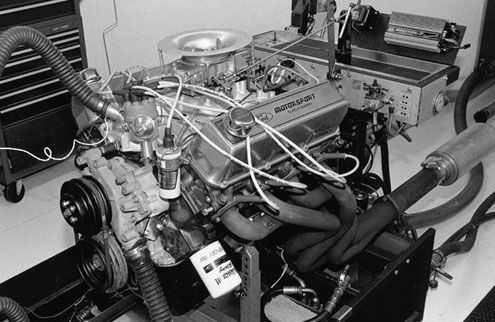
"This ain't no stinkin' Chevy, man." In the beginning, we thought it would... be another simple, low-buck engine hop, the type we'd done a dozen times before on Chevy motors. Frequent Car Craft readers know the drill: Grab a low-dollar long-block engine assembly, throw headers, a carb, an intake, and a cam at it...then make pretty damn good numbers on the dyno at our favorite test facility, Westech Performance. But this time we'd throw in a couple of twists: The test mule would be an un-Chevy--namely, a big-block Ford 460--and we'd run the combo on affordable 87-octane regular-grade gas.
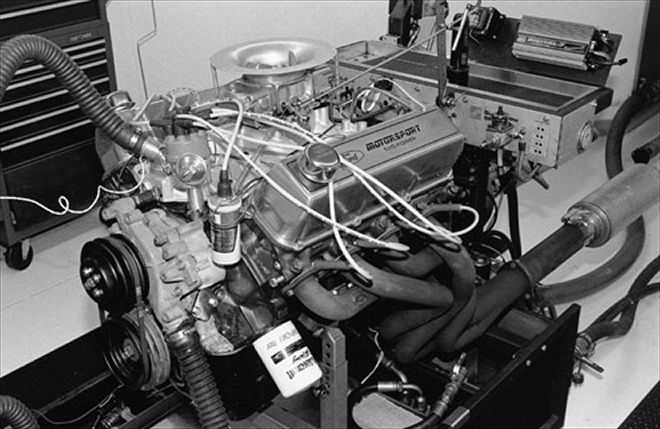 Can an off-the-shelf, low-compression Ford 460 respond to the basic cam, intake, carb, and exhaust improvement routine? Yes--but the devil's in the parts-interchange details!
Can an off-the-shelf, low-compression Ford 460 respond to the basic cam, intake, carb, and exhaust improvement routine? Yes--but the devil's in the parts-interchange details!
Little did we realize what we were in for. When it comes to a Ford big-block, there's no such thing as a simple bolt-on; Ford has changed the 460's basic architecture more often than a Paris salon changes dress styles. This affects basic interchange and makes parts more expensive than parts for a typical small-block Chevy.
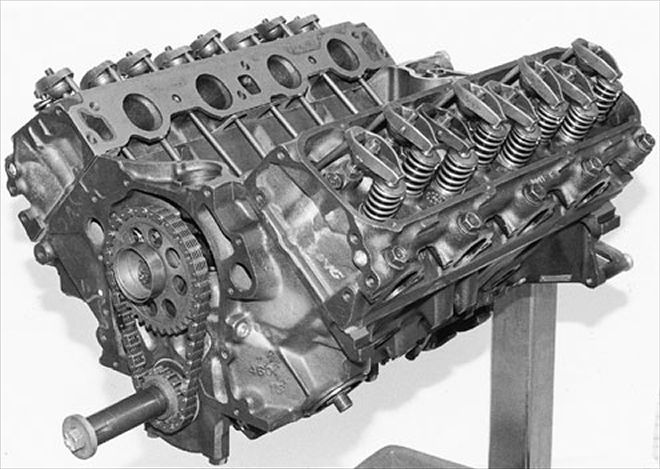
Valvetrain: a Just Solution
The biggest hassle is that nearly all Ford 429/460 engines came stock with nonadjustable valvetrains which don't cut it with any halfway decent performance cam. Converting commonly available '73-and-later 460s with bolt-down, pedestal-mounted rockers to a stud-mounted adjustable valvetrain traditionally requires removing the heads from the engine and expensive remachining. Recently, some aftermarket outfits have developed relatively affordable bolt-on conversions suitable for hydraulic cams at the street-performance level that don't require machining down the pedestals. The '73-'97 heads do have the virtue of large 92-97cc combustion chambers that make it easy to keep compression down, but some sources claim the late chamber shape is inefficient and detonation-prone, even with low-compression ratios. By contrast, '68-'72 429/460 heads have more efficient 72-77cc small chambers, better ports, and stud-mounted rocker arms. Most of these early valvetrains use bottleneck rocker studs and guided rocker arms that, while still nonadjustable in stock form, are easily upgradeable to fully adjustable status. The rub is finding a set of the early heads, then coming up with the right pistons to keep compression down.
Fortunately, RPM Engines, our rebuilt-engine source, was able to build a low-compression engine with early heads. Strangely, the engine still had the standard 460's 4.360-inch bore size! Deep in the hole at TDC, the deep-dish, rebuilder-quality cast pistons only made 8.82:1 compression, but that's what it takes to live on 87 octane.
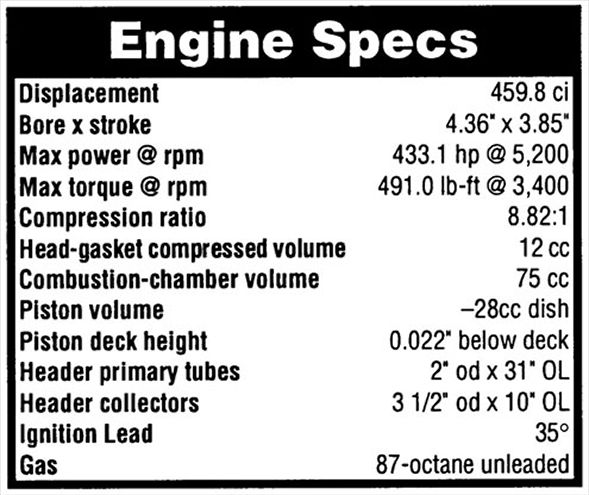
We thought making the valvetrain fully adjustable was simply a matter of screwing in the right rocker-arm studs. But it turns out you also need to replace the guided rockers and nonhardened pushrods with conventional rockers, pushrod guideplates, and different-length pushrods hardened for compatibility with the guideplates. The ends of the Erson studs that thread into the heads were still a tad too long when used with original factory 429 CJ/SCJ 5/16-inch pushrod guideplates, so shim washers were added under the plates.
Lube System: Not an Easy Pickup
As delivered, the long-block assembly didn't have an oil-pump pickup, oil pan, or external tin. Not having a complete core for a parts donor, the pieces were rounded up at the local wrecking yard. Getting the right oil-pump pickup can be tricky: Not only must the pickup match the oil-pan shape (early front-sump or late rear-sump), but both press-in and bolt-on styles have been used. Not all bolt-on pickups have the same bolt spacing either. Our engine's standard- performance oil pump accepted a standard press-in pickup for a front-sump oil pan.
Camshaft: In for the Duration
The engine's as-delivered stock replacement cam was mild even by small-block standards, so upgrading to an aftermarket cam was mandatory. But selecting a cam for a low-compression engine is a fine balancing act. Compensating for efficiency losses seemingly calls for a big cam. On the other hand, low compression degrades bottom-end performance, just like a larger cam does. In the end, we selected a middle-of-the-road Erson TQ40H hydraulic grind; designed to make power in the 2,000- to 5,000-rpm range, it's Erson's largest recommended cam for under-9.5:1 engines. Like most classic Ford V-8 engines, the 429/460 big-block cylinder-head exhaust-port design is compromised to clear tight shock towers on old Ford musclecars; to compensate, this cam features 8 degrees more 0.050-inch duration on the exhaust side (see Valvetrain Specs chart).
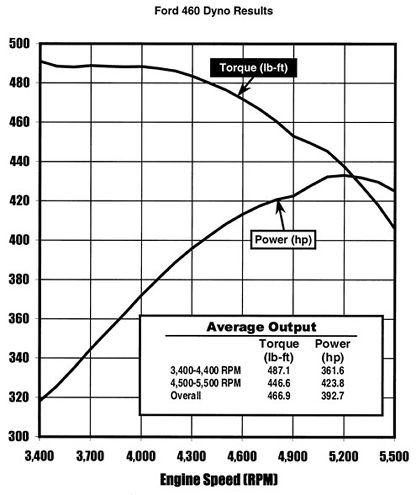 Ford 460 Dyno Results
Ford 460 Dyno Results
Valvesprings: Offset's the Key
Erson's cam required stouter valvesprings than the long-block's wimpy replacement springs, which only developed 50-60 psi of seat pressure. The stouter springs, retainers, and valve-stem locks (keepers) are included in Erson's installation kit. These springs fit the stock spring-pocket diameter, but the pocket depths were too shallow to achieve the correct valvespring installed height. Separately procured aftermarket 0.050-inch positive-offset valvespring locks raised the Erson retainers enough to avoid the need to machine the pockets deeper (which would have required cylinder-head removal).
Bolt-ons: Dressed for Success
As a long-block, the engine came without an intake, carb, distributor, or exhaust. That's OK because a hard-core car crafter doesn't want dowdy stock hardware when it's time for the engine to boogie. We rocked out with Edelbrock's Performer RPM intake topped by a Speed Demon carb. An ACCEL Billetproof distributor provided the fire in the hole, while Hooker headers scavenged the motor. These parts aren't cheap; those on a budget could get by with less-costly generic components, albeit with some performance sacrifice.
Dyno Test: No Runs, No Drips, No Errors
Most of the time, our Westech flogs involve hours of dyno time fine-tuning the combination and swapping on different parts. On the Ford, most of the time was spent tracking down compatible parts to finish off the engine and solve our valvetrain dilemmas. The actual dyno run proved anticlimatic (what a relief). The engine started, it ran, it didn't leak, and it made tire-melting torque, churning out at least 491.0 lb-ft at 3,400 rpm. It may have made even more peak torque, but the dyno brake couldn't hold the motor below 3,400. In fact, torque output was well over 400 lb-ft throughout the 3,400- to 5,500-rpm test range.
The engine didn't quite hit the magic 1hp/ci mark, but 433.1 peak hp at 5,200 rpm from a low-compression smogger is nothing to be ashamed of, especially considering the relatively mild (for a big-block) cam. Raise the compression a point, bolt on some aluminum heads, stab in a thumper camshaft, and you're looking at 500 hp.
Yes, the Ford 460 definitely isn't a Chevy. Things cost more, parts are harder to come by, and you have to beware of design changes. But in the end, this test shows there's plenty of hidden potential waiting to be unleashed. CC